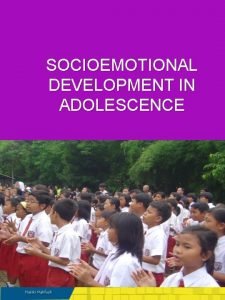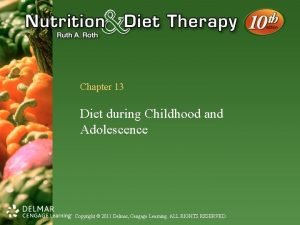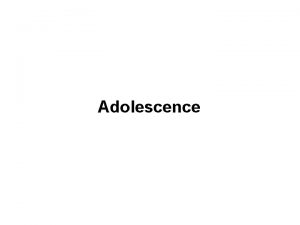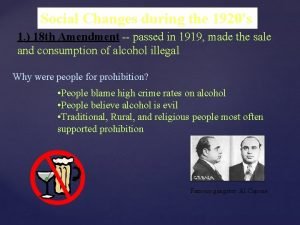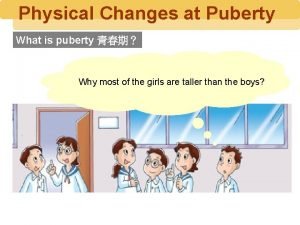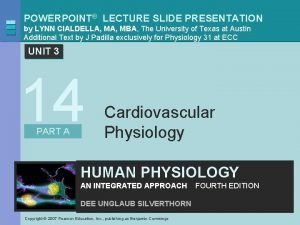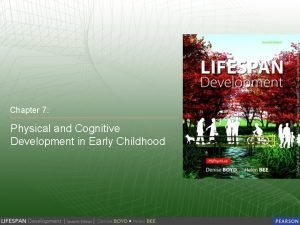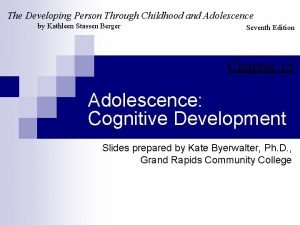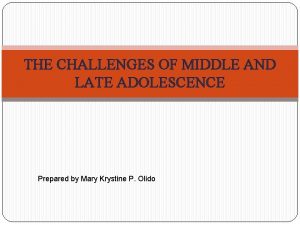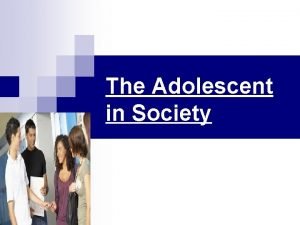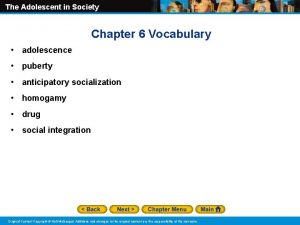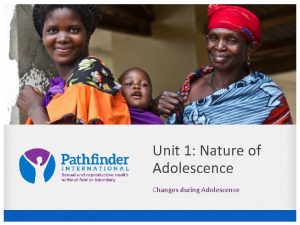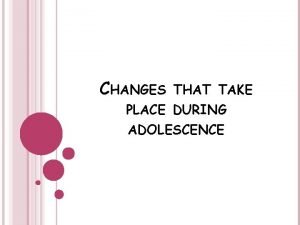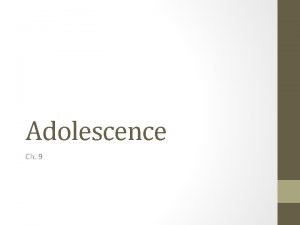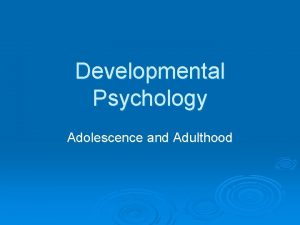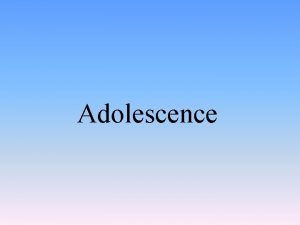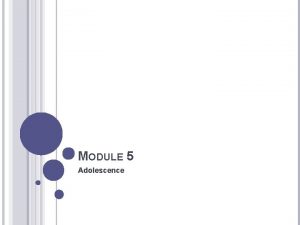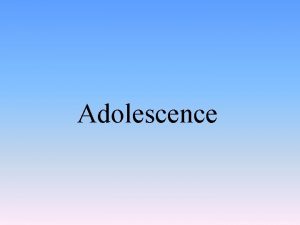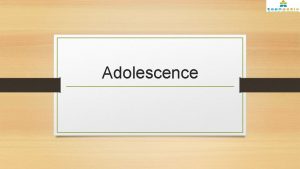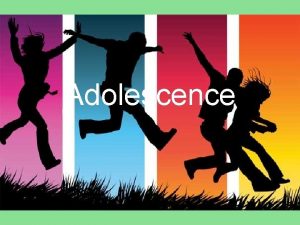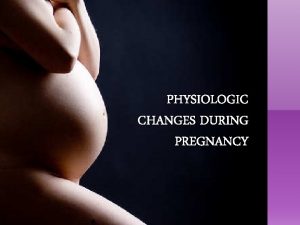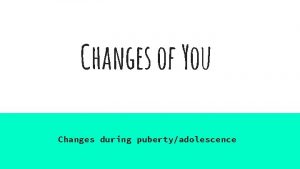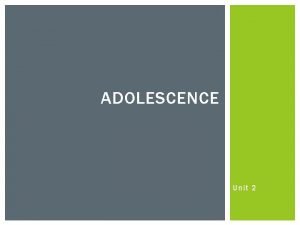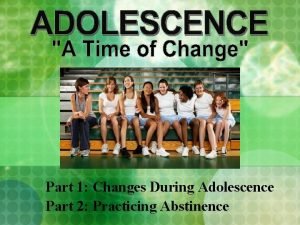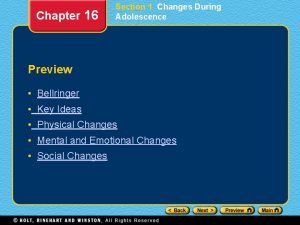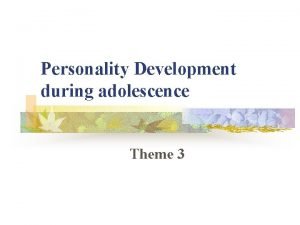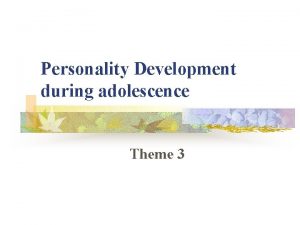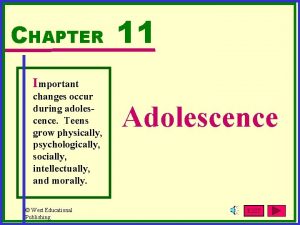Unit 1 Nature of Adolescence Changes during Adolescence




















- Slides: 20

Unit 1: Nature of Adolescence Changes during Adolescence

Adolescence as a life stage was first recognized in the 20 th century, and is now understood by the WHO and many countries as the ages between 10 and 19. Slide 2. 1

Adolescence is a stage of life characterized by changes in young people’s physical, cognitive, and social and emotional development. Slide 2. 2

PHYSICAL CHANGES • Early Adolescence: – Puberty; – growth of body hair; – increased perspiration and oil production in hair and skin; – physical growth (both height and weight); – breast and hip development and onset of menstruation (girls); – growth of testicles and penis, wet dreams, and deepening of voice (boys). • Late Adolescence: – physical growth slows for girls; – physical growth continues for boys. Slide 2. 3

COGNITIVE CHANGES • Early Adolescence: – growth in capacity for abstract thought; – mostly interested in present with little thought for future; – expansion of and increased importance placed on intellectual interests; – deepening of moral thought. • Late Adolescence: – continued growth in capacity for abstract thought; – increased and evolving capacity for goal-setting and decision-making; – interest in moral reasoning; – growth in connection to peer group, community; – questioning of faith, beliefs, and meaning of life; – growing interest in social justice, equity, and fairness. Slide 2. 4

SOCIAL AND EMOTIONAL CHANGES • Early Adolescence: – Struggle with sense of identity; – feel awkward about themselves and their body; – worry about being ‘normal’; – developing critical lens of and heightened conflict with parents; – increasing identification with peer group; – increase in desire for independence; – prone to mood swings; – beginning to test rules and boundaries; – increased interest in privacy; – increased awareness of sexual desire. Slide 2. 5

SOCIAL AND EMOTIONAL CHANGES • Late Adolescence: – Intense self-involvement, alternating between high expectations and poor self -identity; – adjustments to changing body and corresponding swings in self-esteem and confidence; – worry about being ‘normal’ and comparing self to others in peer group; – occasionally fluid or rapidly changing understanding of sexuality and gender; – heightened sense of justice and fairness; – increased drive for independence with resultant distance from parents or other authority figures; – increasing awareness of responsibilities to family and community; – greater reliance on friendship networks and peer group; – heightened capacity for emotional regulation; – experience feelings of love and passion; – increasing interest in sex. Slide 2. 6

• Although we define adolescence as those between the ages of 10 and 19, young people aged 20 -24 can also be considered as the final stage of adolescence or “young adulthood. ” During the early 20 s, young people continue to mature and research shows that the brain continues to develop until the mid-20 s. In young adulthood, young people once again become closer to their families and communities, but these years may still be a time of uncertainty. Young people feel social pressure and experience new types of challenges related to their schooling, employment, and decisions about intimate and family relationships. No matter when they decide to begin a sexual relationship, they have the right to the information and services they need to protect themselves from unwanted SRH outcomes. Slide 2. 7

Evolving Capacity 9

In 1989, the United Nations Convention on the Rights of the Child adopted the concept of “evolving capacity. ” This term has special meaning for health providers who work with adolescents. Evolving capacity integrates ideas about individuality, autonomy, and empowerment, meaning that as children acquire enhanced competencies, there is less need for protection and a greater capacity to take responsibility for decisions affecting their lives. The Convention also recognizes that children in different environments, cultures, and faced with diverse life experiences will acquire competencies at different ages. Health care providers can contribute balancing young people’s need for accurate information and guidance while acknowledging their desire to make independent decisions -- including about sex and sexuality. Slide 2. 8

EVOLVING CAPACITY How does one assess the actual evolving capacity of an individual adolescent client? Here are some simple points to keep in mind: • Young people have valuable knowledge about their own health and well-being. Encourage dialogue and listen to what young people have to say – both verbally and non-verbally. • Determine if adolescents are voluntarily seeking services. Give adolescents information, explore choices and provide them with opportunities to make their own decisions. At a minimum, all young people have a right to express an opinion and to have that opinion considered in decisions about their health care. Don’t make decisions for them. Slide 2. 9

EVOLVING CAPACITY • Always regard adolescents as your main interlocutors, even when they visit a clinic accompanied by a family member or caregiver. • Disability does not necessarily affect adolescents’ capacity to take action for their own wellbeing, but many people mistakenly believe the opposite. Allow yourself to fully assess the capacity of all adolescents—independent of their disability. Ensure you give all adolescents the opportunity to express themselves and make their own decisions. • The decision to visit a clinic already demonstrates responsibility and willingness to take action for their own health and wellbeing. Acknowledge and commend their action. Slide 2. 10

Sexual Rights and Reproducti ve Rights

SEXUAL RIGHTS AND REPRODUCTIVE RIGHTS • The United Nations states that human rights are rights inherent to all human beings, regardless of race, sex, nationality, ethnicity, language, religion, disability, or any other status. • Human rights include the right to life and liberty, freedom from slavery and torture, freedom of opinion and expression, the right to work and education, the right to vote, the right to health, the right to equality, and many more. The right to health includes sexual and reproductive health. • UNFPA states that good sexual and reproductive health is a state of complete physical, mental and social well-being in all matters relating to the reproductive system. It implies that people are able to have a satisfying and safe sex life, the capability to reproduce, and the freedom to decide if, when, and how often to do so. Slide 2. 11

SEXUAL RIGHTS AND REPRODUCTIVE RIGHTS • People need access to accurate information and the safe, effective, affordable and acceptable contraception method of their choice. They must be informed and empowered to protect themselves from sexually transmitted infections and HIV. And when they decide to have children, women must have access to services that can help them have a healthy pregnancy, safe delivery, and healthy baby. • Every individual, including adolescent, has the right to make their own choices about their sexual and reproductive health. This includes the right to make well-informed, independent decisions, and to be provided with information about sexuality and sexual and reproductive health (SRH) and well-being guidance from a trained professional, and quality SRH services. Adolescents with disabilities have the same SRH rights of their peers without disabilities. These equal rights are affirmed by articles 23 and 25 of the United Nations Convention on the Rights of Persons with Disabilities (CRPD), a comprehensive human right instrument adopted in December 2006 and currently ratified by 177 states. Please refer to the chapter “Adolescents with disabilities” to learn more about the CRPD. Slide 2. 12

SRH DEFINITIONS • The WHO defines sexual health as: a state of physical, mental and social well-being in relation to sexuality. It requires a positive and respectful approach to sexuality and sexual relationships, as well as the possibility of having pleasurable and safe sexual experiences, free of coercion, discrimination and violence. Source: World Health Organization • The UN defines reproductive health as: a state of complete physical, mental and social well-being, and not merely the absence of reproductive disease or infirmity. Reproductive health deals with the reproductive processes, functions and system at all stages of life. Source: UNFPA Slide 2. 13

SOURCES FOR SEXUAL & REPRODUCTIVE RIGHTS (SRR) Sexual and reproductive rights come from established human rights principles and protections. These protections are spelled out in national laws and policies, regional human rights documents and in major international conventions, including: • The Program of Action of the 1994 International Conference on Population and Development and subsequent review documents • The Program of Action of the 1995 4 th World Conference on Women • The Convention on the Elimination of all forms of Discrimination Against Women (CEDAW) • The Convention on the Rights of the Child • The Convention on the Rights of Persons with Disabilities (CRPD) • The Maputo Protocol on the Rights of Women in Africa • The agreed conclusions of the annual Commission on the Status of Women and the Commission on Population and Development Slide 2. 14

ADOLESCENTS’ SEXUAL AND REPRODUCTIVE RIGHTS Policies and conventions establish that everyone, including adolescents, have the right to freely, without fear, coercion, violence, or discrimination: • Make decisions about their own health, body, sexual life, and identity. • Ask for and receive information about sex, contraception, and related health services. • Have access to comprehensive education on human sexuality, sexual and reproductive health, human rights, and gender equality. • Decide whether and when to have children. • Choose whether or not to marry and what type of family to create. • Have access to comprehensive and integrated sexual and reproductive health services. • Live free from rape and other violence, including forced pregnancy, forced abortion, sterilization without consent, forced marriage, or female genital mutilation/cutting. Source: Amnesty International Slide 2. 15

SEXUAL RIGHTS Good sexual and reproductive health is underpinned by sexual rights. Many governments, institutions, and individuals deny young people’s sexuality and agency and promote the common misconception that young people are not, or should not be, sexual beings. Sexual rights, when applied to adolescents, includes the following principles: • Sexuality is an integral part of being human for all young people. • Sexuality and sexual pleasure are important for all young people, regardless of reproductive desires. • The evolving capacities of all children and young people must be recognized. Slide 2. 16

twitter. com/Pathfinder. Int facebook. com/Pathfinder. International Youtube/user/Pathfinder. Int
 It is a self portrait composed of many pieces
It is a self portrait composed of many pieces Social changes in adolescence
Social changes in adolescence Eating a balanced diet during childhood and adolescence
Eating a balanced diet during childhood and adolescence Physical development during adolescence
Physical development during adolescence Changes in latitudes, changes in attitudes meaning
Changes in latitudes, changes in attitudes meaning Example of physical and chemical change
Example of physical and chemical change 1920s social changes
1920s social changes Is puberty a physical or chemical change
Is puberty a physical or chemical change Physical changes during early adulthood
Physical changes during early adulthood Wiggers diagram template
Wiggers diagram template Physical changes during childhood
Physical changes during childhood Collision theory states that
Collision theory states that Nature and nature's law lay hid in night
Nature and nature's law lay hid in night Determinace lidské psychiky
Determinace lidské psychiky Unit 10, unit 10 review tests, unit 10 general test
Unit 10, unit 10 review tests, unit 10 general test List of things a to z
List of things a to z Adolescent egocentrism
Adolescent egocentrism Developing person through childhood and adolescence answers
Developing person through childhood and adolescence answers Middle and late adolescence challenges
Middle and late adolescence challenges Undefined status adolescence
Undefined status adolescence Adolescence vocabulary
Adolescence vocabulary
